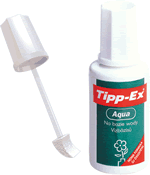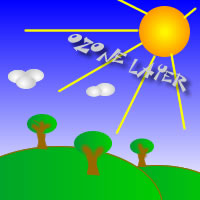3.2.8 Haloalkanes - Synthesis of chloroalkanes
Students should:
|
Free radical substitution
Alkanes undergo few reactions, as the bonds between carbon and carbon and carbon and hydrogen are strong. However, in teh presence of ultraviolet light halogens react directly wth alkanes forming a mixture of products. This can be exemplified by the reaction between methane and chlorine.
The chlorine is dissociated into free atoms by the ultraviolet light. The chlorine chlorine bond is relatively weak, 242 kJ mol-1, and is broken by the high energy ultraviolet light, which promotes an electron into an antibonding orbital.
This results in free chlorine atoms (free radicals), which are very reactive. These then collide with other particles and cause a chain reaction of the type:
Chlorine free radical + neutral species  Other free radical + other neutral species
Other free radical + other neutral species
As a free radical is generated in the equation it can continue reacting. This is why it is called a chain reaction. In the case of the reaction betweeen chlorine and methane the first stage is the initiation reaction:
Cl2  2Cl•
2Cl•
Then there are many propagation reactions which result in new free radical being formed:
Cl• + CH4  HCl + CH3•
HCl + CH3•
Cl2 + CH3•  Cl• + CH3Cl
Cl• + CH3Cl
Finally the chain comes to an end with a termination reaction when two free radicals collide:
Cl• + CH3•  CH3Cl
CH3Cl
Of course, it is also possible for chloromethane to react in the same way as methane making dichloromethane, trichloromethane and tetrachloromethane. This is typical of free radical mechanisms- there is a mixture of products formed
Haloalkanes are important compounds as they are more reactive than alkanes and can be used as useful intermediates in many reactions. They are also valuable solvents.
Solvents
A solvent is a non-aqueous liquid used for dissolving relatively non-polar substances. Chlorinated hydrocarbons are good solvents and have been used with relative frequency in this role for many years.

1,1,1-trichloroethane used to be the solvent of choice for white-out correction fluids used to correct typed documents. The solvent dissolves the white paint and then evaporates rapidly to leave the white layer behind. Nowadays these correction fluids are water based.
One class of solvents achieved notoriety, the chlorofluorocarbons, hydrocarbon molecules with substituted chorine and fluorine atoms. These CFCs were used in aerosols as solvents to carry the contents and allow application in the form of a spray.
However, it became apparent that the relative stability of the CFCs was also a problem as they tended to persist in the environment. After diffusing to the upper atmosphere the abundant ultraviolet light caused them to break apart and produce chlorine free radicals.
Cl2 ![]() 2Cl•
2Cl•
These free radicals react with the ozone in the upper atmosphere and remove it, causing the so-called hole in the ozone layer.
Cl• + O3 ![]() ClO• + O2
ClO• + O2
ClO• + O3 ![]() 2O2 + Cl•
2O2 + Cl•
In this reaction, the chlorine free radical is effectively behaving as a catalyst in that it is regenerated at the end of the reaction. This allows one chlorine free radical to cause the breakdown of hundreds of ozone molecules, before finally meeting another free radical (termination).
The ozone layer
Ozone is an allotrope of oxygen gas with three atoms of oxygen per molecule. Although the Lewis structure suggests that one pair of oxygen atoms are held together by a double bond and the third is datively coordinated to the oxygen pair, both oxygen oxygen bonds are identical.
The actual structure is a resonance hybrid (average) of the two Lewis structures.

The ozone layer is a region of the atomsphere with a higher concentration of
ozone, formed by the interaction of ultraviolet light and oxygen molecules.
It is important because it acts as a barrier between the UV light and the surface
of the earth. If UV light arrives at the surface with any great intensity it
is extremely harmful for living organisms.
One of the effects of a diminishing concentration of ozone in the ozone layer is an increased incidence of skin cancer. It should be emphasised here that this is nothing to do with the greenhouse effect, although many students mix them up.
It is because of the need to protect the ozone layer that legislation is now in place preventing the use of CFCs in aerosol cans.